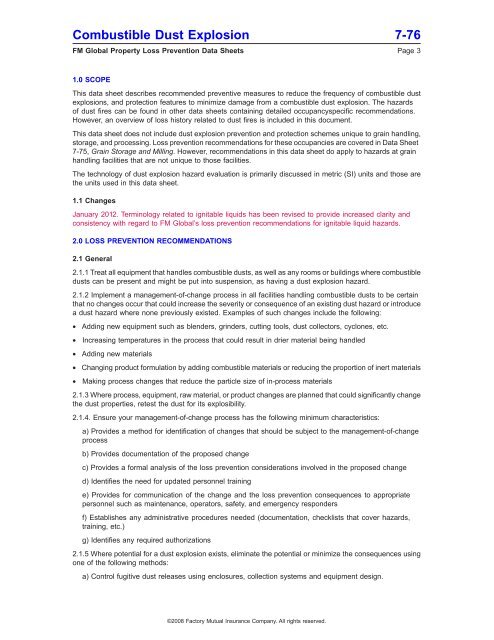DS 7-76 Prevention and Mitigation of Combustible Dust ... - FM Global
DS 7-76 Prevention and Mitigation of Combustible Dust ... - FM Global
DS 7-76 Prevention and Mitigation of Combustible Dust ... - FM Global
Create successful ePaper yourself
Turn your PDF publications into a flip-book with our unique Google optimized e-Paper software.
<strong>Combustible</strong> <strong>Dust</strong> Explosion 7-<strong>76</strong><br />
<strong>FM</strong> <strong>Global</strong> Property Loss <strong>Prevention</strong> Data Sheets Page 3<br />
1.0 SCOPE<br />
This data sheet describes recommended preventive measures to reduce the frequency <strong>of</strong> combustible dust<br />
explosions, <strong>and</strong> protection features to minimize damage from a combustible dust explosion. The hazards<br />
<strong>of</strong> dust fires can be found in other data sheets containing detailed occupancyspecific recommendations.<br />
However, an overview <strong>of</strong> loss history related to dust fires is included in this document.<br />
This data sheet does not include dust explosion prevention <strong>and</strong> protection schemes unique to grain h<strong>and</strong>ling,<br />
storage, <strong>and</strong> processing. Loss prevention recommendations for these occupancies are covered in Data Sheet<br />
7-75, Grain Storage <strong>and</strong> Milling. However, recommendations in this data sheet do apply to hazards at grain<br />
h<strong>and</strong>ling facilities that are not unique to those facilities.<br />
The technology <strong>of</strong> dust explosion hazard evaluation is primarily discussed in metric (SI) units <strong>and</strong> those are<br />
the units used in this data sheet.<br />
1.1 Changes<br />
January 2012. Terminology related to ignitable liquids has been revised to provide increased clarity <strong>and</strong><br />
consistency with regard to <strong>FM</strong> <strong>Global</strong>’s loss prevention recommendations for ignitable liquid hazards.<br />
2.0 LOSS PREVENTION RECOMMENDATIONS<br />
2.1 General<br />
2.1.1 Treat all equipment that h<strong>and</strong>les combustible dusts, as well as any rooms or buildings where combustible<br />
dusts can be present <strong>and</strong> might be put into suspension, as having a dust explosion hazard.<br />
2.1.2 Implement a management-<strong>of</strong>-change process in all facilities h<strong>and</strong>ling combustible dusts to be certain<br />
that no changes occur that could increase the severity or consequence <strong>of</strong> an existing dust hazard or introduce<br />
a dust hazard where none previously existed. Examples <strong>of</strong> such changes include the following:<br />
• Adding new equipment such as blenders, grinders, cutting tools, dust collectors, cyclones, etc.<br />
• Increasing temperatures in the process that could result in drier material being h<strong>and</strong>led<br />
• Adding new materials<br />
• Changing product formulation by adding combustible materials or reducing the proportion <strong>of</strong> inert materials<br />
• Making process changes that reduce the particle size <strong>of</strong> in-process materials<br />
2.1.3 Where process, equipment, raw material, or product changes are planned that could significantly change<br />
the dust properties, retest the dust for its explosibility.<br />
2.1.4. Ensure your management-<strong>of</strong>-change process has the following minimum characteristics:<br />
a) Provides a method for identification <strong>of</strong> changes that should be subject to the management-<strong>of</strong>-change<br />
process<br />
b) Provides documentation <strong>of</strong> the proposed change<br />
c) Provides a formal analysis <strong>of</strong> the loss prevention considerations involved in the proposed change<br />
d) Identifies the need for updated personnel training<br />
e) Provides for communication <strong>of</strong> the change <strong>and</strong> the loss prevention consequences to appropriate<br />
personnel such as maintenance, operators, safety, <strong>and</strong> emergency responders<br />
f) Establishes any administrative procedures needed (documentation, checklists that cover hazards,<br />
training, etc.)<br />
g) Identifies any required authorizations<br />
2.1.5 Where potential for a dust explosion exists, eliminate the potential or minimize the consequences using<br />
one <strong>of</strong> the following methods:<br />
a) Control fugitive dust releases using enclosures, collection systems <strong>and</strong> equipment design.<br />
©2008 Factory Mutual Insurance Company. All rights reserved.

















